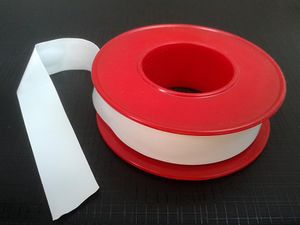Difference between revisions of "Polytetrafluoroethylene"
(→Chemical) |
(→Chemical) |
||
| Line 8: | Line 8: | ||
High temperatures cause PTFE to decompose into lower perfluorocarbons, some of which are very toxic. Reactions with moisture in the air also cause a small amount of HF to form. | High temperatures cause PTFE to decompose into lower perfluorocarbons, some of which are very toxic. Reactions with moisture in the air also cause a small amount of HF to form. | ||
| − | Very high temperatures cause PTFE to liberate elemental fluorine, which makes it useful as an oxidizer for [[flash powder]]s. | + | Very high temperatures cause PTFE to liberate elemental fluorine, which makes it useful as an oxidizer for [[flash powder]]s, in which the fluorine immediately and very energetically reacts with a metal such as aluminium or magnesium. |
===Physical=== | ===Physical=== | ||
Revision as of 10:28, 5 August 2015
Polytetrafluoroethylene or PTFE or Teflon is a synthetic fluoropolymer of tetrafluoroethylene, well known for its chemical inertness and very low coefficient of friction.
Contents
Properties
Chemical
PTFE is extremely resistant to chemical attacks, being only affected by molten alkali and strong fluorinating agents such as cobalt(III) fluoride and xenon difluoride. Teflon strips appear to burn in air, but it's most likely that the pyrolysis products are the one that catch fire. It will however burn when mixed with magnesium powder.
High temperatures cause PTFE to decompose into lower perfluorocarbons, some of which are very toxic. Reactions with moisture in the air also cause a small amount of HF to form.
Very high temperatures cause PTFE to liberate elemental fluorine, which makes it useful as an oxidizer for flash powders, in which the fluorine immediately and very energetically reacts with a metal such as aluminium or magnesium.
Physical
PTFE is a white solid at room temperature, with a melting point of 327 °C. Its density is 2.2 g/cm3. PTFE maintains mechanical properties down to temperatures of 5 K (−268.15 °C), and has good flexibility at temperatures above −79 °C. Teflon materials however have poor mechanical properties and are susceptible to creep. When melted, PTFE has the consistency of paste which slowly decomposes, so items can only be cast via injection.
Availability
PTFE is cheaply available as thread seal tapes. Many lab items, such as stoppers, gaskets, sleeves, magnetic stirrers are made of it and can be easily procured online. However, items made of PTFE are expensive, as PTFE cannot be molded like the more common type of plastics.
Preparation
PTFE is made via polymerization of tetrafluoroethylene. This process is difficult and expensive for the amateur chemist.
Projects
Handling
Safety
PTFE, being chemically inert, is non-toxic. Its pyrolysis is detectable at 200 °C, giving off fluorocarbon gases, that in large quantities can be dangerous for humans and are very toxic to wildlife, such as birds.
Storage
No special storage is required.
Disposal
Being chemically inert, PTFE poses hazard to the environment, as it cannot be digested by wildlife.
